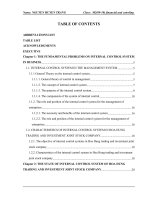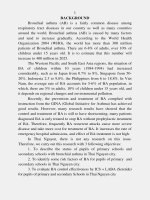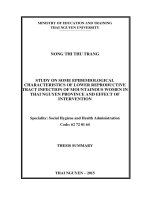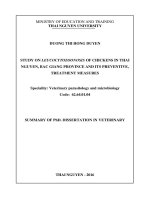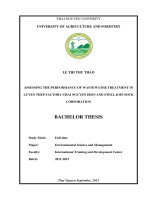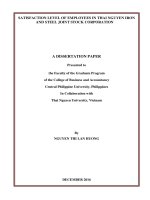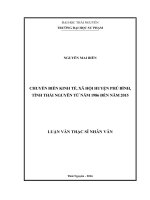Satisfaction level of employees in Thai Nguyen Iron and Steel joint stock corporation (LV thạc sĩ)
Bạn đang xem bản rút gọn của tài liệu. Xem và tải ngay bản đầy đủ của tài liệu tại đây (2.07 MB, 115 trang )
SATISFACTION LEVEL OF EMPLOYEES IN THAI NGUYEN IRON
AND STEEL JOINT STOCK CORPORATION
A DISSERTATION PAPER
Presented to
the Faculty of the Graduate Program
of the College of Business and Accountancy
Central Philippine University, Philippines
In Collaboration with
Thai Nguyen University, Vietnam
In Partial Fulfillment
Of the Requirements for the Degree
DOCTOR OF MANAGEMENT
NGUYEN THI LAN HUONG
MARCH 2017
i
ACKNOWLEDGMENT
The researcher would like to express her most professional thanks and gratitude to the
following person who made significant contribution for successful completion of this study:
Assoc. Prof. Dr Hoang Thi Thu for her great support and guidance towards the
completing of this research work.
The employee of CPU and TUEBA, whose tutelage through the years, provided the
researcher with the necessary background skills to undertake and complete this study.
The research‟s co-worker for the kind support and for sharing their time and
experience that motivated the researcher to work toward the successful completion of this
study.
Her husband and children for their unconditional and understanding, love and support that
gave the researcher the encourage and inner drive that made possible the successful conduct of
this study.
Thai Nguyen, March 2017
Nguyen Thi Lan Huong
ii
TABLE OF CONTENTS
LIST OF TABLES .................................................................................................................... v
LIST OF FIGURES ................................................................................................................ vii
ABSTRACT ...........................................................................................................................viii
CHAPTER I .............................................................................................................................. 1
INTRODUCTION .................................................................................................................... 1
1.1. Background and rationale of the study ............................................................................ 1
1.2. Objectives ........................................................................................................................ 3
1.3. Theoretical framework ..................................................................................................... 3
1.4. Conceptual framework ................................................................................................... 11
1.5. The operational definitions ............................................................................................ 12
1.6. Significance of the study................................................................................................ 15
1.7. Scope and limitation of the study .................................................................................. 16
CHAPTER II .......................................................................................................................... 17
REVIEW OF RELATED LITERATURE AND STUDIES ............................................... 17
2.1. Theoretical foundation ................................................................................................... 17
2.1.1. Defining job satisfaction ......................................................................................... 17
2.1.2. Importance of job satisfaction of employees and its relationship with job
performance ....................................................................................................................... 18
2.1.3. Measuring job satisfaction ...................................................................................... 19
2.2. Empirical related studies ................................................................................................ 20
CHAPTER III ......................................................................................................................... 27
RESEARCH METHODOLOGY .......................................................................................... 27
3.1. Research Design ............................................................................................................ 27
3.2. Population, Sample Size and Sampling Technique ....................................................... 27
3.3. Research Instruments ..................................................................................................... 29
3.4. Ethical Consideration ..................................................................................................... 29
3.5. Data Gathering Procedures ............................................................................................ 29
iii
3.6. Data Processing and Data Analysis ............................................................................... 32
CHAPTER IV ......................................................................................................................... 34
DATA PRESENTATION, ANALYSIS AND INTERPRETATION ................................ 34
4.1 Thai Nguyen Iron and Steel Joint Stock Corporation introduction ................................ 34
4.1.1 General informations ................................................................................................ 34
4.1.2 Organizational structure ........................................................................................... 36
4.1.3 Business Situation of TISCO ................................................................................... 37
4.2. Situation of human resources of TISCO ........................................................................ 38
4.2.1 The structure of human resources ............................................................................ 38
4.2.1.1 Employee Structure by gender .............................................................................. 38
4.2.1.2 Employees structure by age group ........................................................................ 39
4.2.1.3 Employees structure by level of education and training ....................................... 40
4.2.1.4 Employees structure according to the nature of work ........................................... 40
4.2.2 Salaries, bonuses and Welfare of employees ........................................................... 40
4.2.3 Working condition of employee ............................................................................... 41
4.2.4 Opportunity for advancement................................................................................... 41
4.2.5 Personal relationships............................................................................................... 41
4.3 Evaluating the results of the employee satisfaction of TISCO ....................................... 41
4.3.1 General information about respondents. .................................................................. 41
4.3.2 Descriptive statistics................................................................................................. 43
4.3.3 Test for reliability by Cronbach Alpha .................................................................... 48
4.3.4 Exploratory Factor Analysis EFA ............................................................................ 52
4.3.5. Correlation Analysis................................................................................................ 58
4.3.6 Regression analysis and hypothesis testing .............................................................. 59
4. 5. Differences of Job Satisfaction by characteristics of workers ...................................... 75
4.5.1 Difference of Job Satisfaction by “gender”............................................................. 75
4.5.2 Difference of Job Satisfaction by “Age groups”. ..................................................... 76
4.5.3 Difference of Job Satisfaction by “marital status”. ................................................. 77
iv
4.5.4 Difference of Job Satisfaction by “education”. ....................................................... 78
CHARTER V .......................................................................................................................... 80
SUMMARY, CONCLUSION AND RECOMMENDATION ............................................ 80
5.1 Summary ......................................................................................................................... 80
5.1.1 Research objective and methodology....................................................................... 80
5.1.2 Results of multiple regression analysis .................................................................... 80
5.2. Conclusions .................................................................................................................... 82
5.3 Recommendation ............................................................................................................ 83
REFERENCES ....................................................................................................................... 88
APPENDICES......................................................................................................................... 95
v
LIST OF TABLES
Table 3. 1 Sample size of participants from each department in TISCO Thai Nguyen ........... 28
Table 3. 2 The 5- Likert scale ................................................................................................... 29
Table 3. 3 Sample of member in TISCO Thai Nguyen by kind employees ............................. 31
Table 3. 4 Cronbach alpha coefficient scale ............................................................................. 32
Table 4. 1 Balance company audit results ................................................................................ 37
Table 4. 2 Report on business results of the Company ............................................................ 38
Table 4. 3 Employee Structure by gender ................................................................................ 39
Table 4. 4 Employees structure by age group .......................................................................... 39
Table 4. 5 Employees structure by level of education and training ......................................... 40
Table 4. 6 Number of questionnaire sent out and collected ..................................................... 42
Table 4. 7 Frequency and percentage of employees by characteristics of participants (n = 367)
.................................................................................................................................................. 43
Table 4. 8 Descriptive Statistics of total employees................................................................. 44
Table 4. 9 Descriptive Statistics of Indirect employees ........................................................... 44
Table 4. 10 Descriptive Statistics of direct employees ............................................................. 45
Table 4. 11 Descriptive statistics of “Supervisors”factor ......................................................... 45
Table 4. 12 Descriptive statistics of “Co-worker” factor ......................................................... 46
Table 4. 13 Descriptive statistics of “Working conditions” factor. .......................................... 46
Table 4. 14 Descriptive statistics of “Financial reward” factor. ............................................... 46
Table 4. 15 Descriptive statistics of “Opportunity for advancement” factor ........................... 47
Table 4. 16 Descriptive statistics of “Salary” factor ................................................................ 47
Table 4. 17 Descriptive statistics of “Nature of work” factor .................................................. 48
Table 4. 18 Cronbach Alpha of Nature of work ....................................................................... 48
Table 4. 19 Cronbach‟s alpha of salary .................................................................................... 49
Table 4. 20 Cronbach‟s alpha of Opportunity for advancement .............................................. 49
Table 4. 21 Cronbach‟s alpha of Supervisors ........................................................................... 50
Table 4. 22 Cronbach Alpha of Co-workers............................................................................. 50
Table 4. 23 Cronbach Alpha of Working conditions................................................................ 50
Table 4. 24 Cronbach Alpha of Financial reward .................................................................... 51
Table 4. 25 Cronbach Alpha of Satisfactions ........................................................................... 52
Table 4. 26 The result of EFA test for factors influencing job satisfaction of employees ....... 52
Table 4. 27 The result of EFA retest for factors influencing job satisfaction of employees .... 55
Table 4. 28 EFA test for influencing job satisfaction factors ................................................... 56
vi
Table 4. 29 EFA test for influencing job satisfaction factors. .................................................. 57
Table 4. 30 Correlation coeefficients ....................................................................................... 58
Table 4. 31 Descriptive Statistics of general employees .......................................................... 59
Table 4. 32 Job satisfaction of Indirect employees .................................................................. 60
Table 4. 33 Descriptive Statistics of direct employees ............................................................. 61
Table 4. 34 Descriptive Statistics of “Nature of work” factor................................................. 61
Table 4. 35 Descriptive Statistics of “Supervisors” factor ....................................................... 62
Table 4. 36 Descriptive Statistics of “Co-worker” factor ......................................................... 62
Table 4. 37 Descriptive Statistics of “Working conditions” factor .......................................... 63
Table 4. 38 Descriptive Statistics of “Financial reward” factor ............................................... 63
Table 4. 39 Descriptive Statistics of “Opportunity for advancement” factor ........................... 63
Table 4. 40 Descriptive Statistics of “Salary” factor ................................................................ 64
Table 4. 41 Regression model of general employees ............................................................... 66
Table 4. 42 Regression model of direct employees .................................................................. 69
Table 4. 43 Regression model of indirect employeess ............................................................. 72
Table 4. 44 Results of One-Way Anova test of “gender” ........................................................ 75
Table 4. 45 Results of One-Way Anova test of “Age groups” ................................................. 76
Table 4. 46 Result of Bonferroni test of “Age groups” ............................................................ 77
Table 4. 47 Results of One-Way Anova test of “marital status” ............................................. 77
Table 4. 48 Results of One-Way Anova test of “education” ................................................... 78
Table 4. 49 Result of Bonferroni test of “education” ............................................................... 79
Table 5. 1 Coefficients three multiple regression ..................................................................... 81
vii
LIST OF FIGURES
Figure 1. 1 Abraham Maslow‟s need hierarchy theory .............................................................. 5
Figure 1. 2 Maslow‟s hierarchy of needs and application in the workplace .............................. 5
Figure 1. 3 Herzberg‟s two factors theory .................................................................................. 8
Figure 1. 4 Summarizing the need theories ................................................................................ 9
Figure 1. 5 Theoretical framework ........................................................................................... 11
Figure 1. 6 Conceptual framework ........................................................................................... 12
Figure 2. 1 Measure job satisfaction by faces .......................................................................... 20
Figure 4. 2 Research framework: Adjusted model ................................................................... 57
Figure 4. 3 Homoscedasticity ................................................................................................... 64
Figure 4. 4 Histogram chart ...................................................................................................... 65
Figure 4. 5 P-P plot chart .......................................................................................................... 65
viii
ABSTRACT
The purposes of this study were to examine Studies on job satisfaction have been
conducted and applied including both theoretical and practical aspects. In context of needing
to improving quality of work performance in manufacturing enterprises, surveying on
employee‟s job satisfaction has been done in previous researches. However, there have not
been separate studies on employee‟s satisfaction at administrative area toward their job (direct
employes) as well as employee‟s satisfaction production area toward their job (indirect
employees).
The findings showed in previous part have many theoretical and practical
implications. This section summarizes all these implications. Firstly, the findings of this
study are different from the previous studies about job satisfaction among employees. The
research determined the job satisfaction level in both direct employees and indirect
employees. Secondly, this dissertation develops a model and empirically tests their
applicability in delivery of pass grassroots level. This study has tested the scales about the
job satisfaction and components of job. It points out that there are 7 components when
considering a job. To be compared with the previous studies, the factors and impact levels on
the satisfaction of employees have some differences. Thirdly, this study objects to understand
how employee satisfaction with their job in Thai Nguyen Iron and Steel joint stock
Corporation TISCO is determined. Even when the satisfaction of employees is medium level
and high, some other aspects of job which are scored low or workers are not satisfied.
Fourthly, the research also shows that whether or not the differences in the satisfaction of
employee according to their personal characteristics. The concern about the relationship
between employee‟s perceptions of components of job like nature of work, salary,
supervisors, co-worker, opportunity for advancement, working condition, financial reward
and the employee‟s job satisfaction in TISCO. We also need to learn about the influence of
these factors as an important part in the future improving the satisfaction of the employees.
This trend requires the operational capacity of administrator and manager in TISCO and
worker knowledge. Fifthly, and finally, this thesis supply helpful information for TISCO can
based on to set up the polices and plans so as to enhance the satisfaction of the employee
about their job. Although. The latter approach generally takes the form of employee‟s
satisfaction surveys or other relevant survey data measuring quality of job or work
performance by worker. Thus, the findings from the survey at TISCO have practical
significance when the TISCO has made reform for a long time.
1
CHAPTER I
INTRODUCTION
1.1. Background and rationale of the study
There are many factors influencing human resource management, of which job
satisfaction is the most important issue among many factors of human resource management
that every manager needs to give much attention.
The term “job satisfaction” is derived from the humanities, psychology and
sociology. In the field of psychology, it is a state where an employee has an emotional
perception of his situation and reacts with feelings of pleasure or pain. In sociology, it is
considered a variable in different categories related to how each employee evaluates and
thinks about his work (Sypniewska, 2013). Job satisfaction can be defined as an individual‟s
total feeling about their job and the attitudes they have towards various aspects or facets of
their job, as well as an attitude and perception that could consequently influence the degree of
fit between the individual and the organization (R. Karthik, S. Saratha, & M. Sowmiya, 2012;
Spector 1997).
For a few decades, many researchers have been carried out about job satisfaction
and its components. Many researchers and administrators have noticed the importance of job
satisfaction on a variety of organizational variables. In particular, it was known that
dissatisfied employees are likely to leave their jobs (E.J. Lumley, et al, 2011). Job satisfaction
among employees is an indicator of organizational effectiveness (R. Karthik, S. Saratha, & M.
Sowmiya, 2012). the study conducted by Harter et al. (2002) found positive and substantive
correlations between employee satisfaction-engagement and the business unit outcomes of
productivity, profit, employee turnover, employee accidents, and customer satisfaction.
Freeman, (2005) shows that businesses that excel in employee satisfaction issues reduce
turnover by 50% from the norms, increase customer satisfaction to an average of 95 % and
lower employee cost by 12%. Carpitella (2003) indicated that the more satisfied an employee
is, the less turnover and absenteeism occurs (Maloney & McFillen, 1986).
Added to that, Job satisfaction plays an important role for an employee in doing their
job performance. Research examining the relationship between job satisfaction and job
performance has been conducted since at least as early as 1945 (Davar, 2012). The idea that
job satisfaction leads to better performance is supported by Vroom's. The study relating to the
relationship between job satisfaction and job performance has now become a research
tradition in industrial-organizational psychology Vroom's (1964).
2
Worldwide, job satisfaction was conducted on many areas and the results were
different. Nolan et al. (1998) found that the vast majority of respondents (85%) considered
that their work was interesting. Regarding job satisfaction and morale, 35% of respondents
considered that their job satisfaction had decreased in the last year and 69% felt that overall
morale had fallen. Price (2002) indicated that over half of the respondents (58%) were
generally satisfied with their job. They identified that highest satisfaction was related to coworkers and extrinsic rewards and that most dissatisfaction was with the amount of control
and responsibility they had and with professional opportunities. Using the same scale, Wang
(2002) found that workforces were more dissatisfied than satisfied and were mostly
dissatisfied with salary and job promotion.
In Vietnam, CareerBuilder (2008) showed that dissatisfaction is growing among the
workers: 25% of employees were bored with their job, 60% of respondents were intending to
leave their current job to go to a different berth in the next two years. Another study indicated
that the respondents ranked their job satisfaction at the moderate level (Vu Thi Kim Trinh,
2013). Duong Cong Vi (2013) revealed that the level of satisfaction among workforces was at
lower and middle range of good level. This finding is accordant with Le Quang Thach‟s
research (2012).
Thus, job satisfaction affects to most of aspects of a factory or company. It is not
only influences to the resource management, employee productivity, product quality but also
changes the customer satisfaction. In worldwide and Vietnam, there have been some studies
were conducted but results from those studies were different. Especially in Vietnam, the
degree of job satisfaction of employee was still low. Hence, the we would like to conduct this
research to determine factors influencing job satisfaction of employees and explain the
relationship existing among them.
Established in 1959, Thai Nguyen Iron and Steel joint Stock Corporation (TISCO),
the cradle of the metallurgical industry of Vietnam is the first an unique metallurgical zone in
Vietnam with an integrated production line from exploiting iron ore to making cast iron, steel
billet and rolling steel. Like the other companies, TISCO have been facing the challenges of
recruiting, and retaining quality workers. The problem is unlike the past years, in conditions
of economic slowdown, the role of human resource professionals has become an integral part
of the organization‟s success. For the TISCO, these challenges are even more complex. So the
question is how to satisfy employees and how to retain them is the most concerned question
of the different levels of management. These studies have been focused mainly on private
sectors. Seldom has been conducted on relationship between job satisfaction and
organizational and individual factors, especially in the case of Thai Nguyen, there is no
3
research on this topic. Thus, the research in evaluating the job satisfaction and determining
the factors influencing job satisfaction is needed.
With the above purposes, this conducts a research on “Satisfaction of employees
in Thai Nguyen Iron and Steel Joint Stock Corporation” was conducted.
Research questions
i)
What is the level of job satisfaction among TISCO‟s employees?
ii)
Is there a difference between level of job satisfaction of direct employees and
indirect employees?
iii)
How may factors influence the job satisfaction of employees in TISCO?
1.2. Objectives
General objectives
This study aims to determine the job satisfaction of employees working in Thai
Nguyen Iron and Steel Joint Stock Corporation. Recommendations for strengthening
employees‟ satisfaction shall be proposed in order to enhance of job efficiency and quality
and consolidation of TISCO personnel.
Specific objectives
The purpose of this study is to evaluate the satisfaction level of the employee in
TISCO and examine its relevant factors. Therefore, the specific objectives of this research are
as follows:
1. To synthesize the relevant theories related to job satisfaction
2. To describe the profile of respondent in term of gender, job position, age, marital
status, educational level, length of work in the company, monthly income, and working
conditions.
3. To determine the job satisfaction level of employee working in TISCO.
4. To identify the effect of Nature of work, Salary, Opportunity for advancement,
Relationship with Supervisors, Respect from Co-Workers, Working conditions, and financial
Rewards on job satisfaction of employees.
5. To propose recommendations for committee to improve the job satisfaction of
employees for keeping of their job productivity and efficiency.
1.3. Theoretical framework
The researcher would like to synthesize the relevant theories related to job
satisfaction by basing on the theory of need, theory of motivation and theory of expectance.
(1) Abraham Maslow’s need hierarchy theory (need based theory)
4
One of the most widely mentioned theories of motivation is the hierarchy of needs
theory put forth by psychologist Abraham Maslow. Maslow saw human needs in the form of a
hierarchy, ascending from the lowest to the highest, and he concluded that when one set of
needs is satisfied, this kind of need ceases to be a motivator. Maslow‟s theory states that
people have a pyramide hierarchy of needs that they will satisfy from bottom to top. There are
deficiency needs, that will stifle any other movement if they‟re not satisfied, and growth
needs, that can be progressively satisfied once the basics have been covered (Argyris, 1957).
Physiological needs: These are important needs for sustaining the human life. Food,
water, warmth, shelter, sleep, medicine and education are the basic physiological needs which
fall in the primary list of need satisfaction. Maslow was of an opinion that until these needs
were satisfied to a degree to maintain life, no other motivating factors can work.
Security or Safety needs: These are the needs to be free of physical danger and of
the fear of losing a job, property, food or shelter. It also includes protection against any
emotional harm.
Social needs: Since people are social beings, they need to belong and be accepted by
others. People try to satisfy their need for affection, acceptance and friendship.
Esteem needs: According to Maslow, once people begin to satisfy their need to
belong, they tend to want to be held in esteem both by themselves and by others. This kind of
need produces such satisfaction as power, prestige status and self-confidence. It includes both
internal esteem factors like self-respect, autonomy and achievements and external esteem
factors such as status, recognition and attention.
Need for self-actualization: Maslow regards this as the highest need in his hierarchy.
It is the drive to become what one is capable of becoming, it includes growth, achieving one‟s
potential and self-fulfillment. It is to maximize one‟s potential and to accomplish something.
5
Figure 1. 1 Abraham Maslow’s need hierarchy theory
Maslow‟s hierarchy of needs applied to work situations implies that managers have
the responsibility, firstly, to make sure their people‟s deficiency needs are met. This means, in
broad terms, a safe environment and proper wages.Secondly, it implies creating a proper
climate in which employees can develop their fullest potential. Failure to do so would
theoretically increase employee frustration and could result in poorer performance, lower job
satisfaction, and increased withdrawal from the organization.
Figure 1. 2 Maslow’s hierarchy of needs and application in the workplace
6
Needs
Physiological
Examples
Cafeterias
Vending machines
Drinking fountains
Security
Economic:
Wages and salaries
Fringe Financial rewards
Retirement Financial rewards
Medical Financial rewards
Psychological: Provide job descriptions
Avoid abrupt changes
Solve employee‟s problems
Physical:
Working conditions
Heating and ventilation
Rest periods
Belongingness
Encourage social interaction
Create team spirit
Facilitate outside social activities
Use periodic praise
Allow participation
Self-esteem
Design challenging jobs
Use praise and awards
Delegate responsibilities
Give training
Encourage participation
Self-actualization
Give training
Provide challenges
Encourage creativity
(2) McClelland’s achievement motivation theory (need based theory)
McCelland‟s theory of needs focuses on just three needs: achievement, power and
affiliation. They are defined as follows:
Need for achievement – The drive to excel, to achieve in relation to a set of
standards, to strive to succeed.
Need for power – The need to make others behave in a way they would not have
behaved otherwise.
Need for affiliation – The desire for friendly and close interpersonal relationships.
7
McClelland (1988) suggests that people with a high achievement need have a
compelling drive to succeed. They strive for personal achievement rather than rewards and
have a desire to do something better or more efficiently than it has been done before. They
seek situations where they can attain personal responsibility for finding solutions to problems,
where they can receive rapid feedback on their performance so they can tell easily whether
they are improving or not, and where they can set moderately challenging goals. It is
important to note that high achievers, as described by McClelland, avoid what they perceive
to be very easy or very difficult tasks. They receive feelings of achievement and satisfaction
from overcoming 50 difficulties and obstacles, but they need to feel that their success (or
failure) is due to their own actions. McClelland postulates that high achievers will perform
best when they perceive there to be an approximately equal chance of success or failure.
McClelland stated that most people possess and exhibit a combination of these
characteristic. Some people exhibit a strong bias to a particular motivational needs, and this
motivational or needs “mix” consequently affects their behavior and working and managing
style. McClelland's theory also allows for the shaping of a person's needs; training programs
can be used to modify one's need profile.
McClelland suggested that a strong need for affiliation affiliation-motivation
undermines a manager's objectivity, because of their need to be liked, and that this affects a
manager's decision-making capability. A strong need for power authority-motivation will
produce a determined work ethicand commitment to the organization, and while “n-pow”
people are attractedto the Supervisorsship role, they may notpossess the required flexibility
and people-centred skills. McClelland argues that need for achievement people with strong
achievement motivation make the best Supervisorss, although there can be a tendency to
demand too much of their employee in the belief that they are all similarly and highly
achievement-focused and results driven, which of course most people are not.
McClelland‟s needs are found to varying degrees in all workers and managers, and
their mix of motivational needs characterizes a person's or manager's style and behavior. Both
in terms of being motivated and in the management and motivation others. People with
different needs are motivated differently.
High need for achievement – High achievers should be given challenging projects
with reachable goals. They should be provided frequent feedback, while the money is not an
important motivator in itself. Rather, it is an effective form of feedback.
High need for affiliation – Employees with a high affiliation need perform best in
a cooperative environment.
8
High need for power – Management should provide power seekers the
opportunity to manage others.
(3) Herzberg’s two factors theory (need based theory)
Herzberg‟s theory is one of the most empirical and compelling theories about
motivation. It‟s the only theory that splits out demotivating factors from motivating factors; it
introduces the concept of movement and motivation. And it “has produced more replications
than any other research in the history of industrial and organizational psychology. The Two
Factor Theory, or Motivation and Hygiene Theory, purports to differentiate between intrinsic
and extrinsic aspects of the job. The authors referred to the intrinsic factors as content or
motivators, and they include: achievement, advancement, the work itself, responsibility, and
recognition. The extrinsic factors were referred to as hygienes and included: company policy
and administration, technical supervision, working conditions, salary, and interpersonal
supervision.
Herzberg avoids using the word „need‟ and maintains that in any work situation, you
can distinguish between two sets of factors. The theory states that job satisfaction and
dissatisfaction are affected by two different sets of factors. Therefore, satisfaction and
dissatisfaction cannot be measured on the same continuum.
Hygiene factors: Features of the work environment which, if present, help avoid
dissatisfaction with work. Concerned with job context e.g work environment, status, company
procedures, quality of supervision. Can be related roughly to Maslow‟s lower-level needs.
Motivators: Features of the job itself that people find enjoyable and that have a
motivational effect. Mainly intrinsic in nature e.g. sense of achievement, recognition,
responsibility. Can be related to Maslow‟s higher-level needs
Motivation Factors
Hygiene Factors
Achievement
Recognition
The work itself
Responsibility
Advancement and growth
Satisfaction
No satisfaction
Supervisors
Working conditions
Interpersonal relations
Pay and security
Company policies and administration
Dissatisfaction
Figure 1. 3 Herzberg’s two factors theory
No Dissatisfaction
9
Summarizing the need based theories
Despite the obvious differences between the need theories discussed in this section,
there are several points at which the theories intersect. Figure 1.4 illustrates the similarities
among the three theories examined. All need-based theories, however, share an inherent
weakness in that “they do an adequate job of describing the factors that motivate behavior, but
they tell us very little about the actual processes of motivation” (Moorhead & Griffin, 1995).
Process based motivation theories provide a better understanding of the ways in which
motivation occurs.
Figure 1. 4 Summarizing the need theories
(4) Victor Vroom’s expectancy theory (process based theory)
The most widely accepted explanation of motivation has been propounded by Victor
Vroom.The Expectancy theory provides a sort of a mechanism for finding out motivation
through a certain type of calculation. The way in which the Expectancy theory works is as
follows:
10
Firstly, Employees have personal goals which they like to achieve and for this
reason they work in organizations. These personal goals can be fulfilled by organizational
rewards or work outcomes. Therefore, the relationship between organizational rewards or
work outcomes and personal goals is important i.e. to what extent organizational rewards
fulfil an employee‟s personal goals and how, attractive are those rewards to the employee.
This relationship can also be expressed as the value the employee gives to the work outcomes.
Secondly, organizational rewards or work outcomes are dependent on the individual
performance of the employee. The level of belief that the individual employee has that his/her
performance will result in achievement of organizational rewards/work outcomes is also
important. And thirdly, the perception of the chances by the individual employee that personal
effort on his/her will lead to high performance is again important. Therefore, there are four
variables for an employee that matter him/her in motivation (Robbins Stephan and Judge
Timothy, 2013). These variables are: 1) Individual effort; 2) Individual performance; 3)
Organizational rewards/work outcomes; 4) Personal goals.
Relationship between Efforts and Performance: This is known as Expectancy (E).
Expectancy explains the subjective probability of the effort resulting in an outcome (called the
first level outcome). The value of expectancy will vary between 0 and 1. 0 level of expectancy
means that our maximum effort will also not result in any change in performance. In other
words the probability of improvement in performance is nil. An expectancy of the level of 1
means that our effort will lead to highly successful or the best performance. In other word, the
probability of improvement is 1 (PareekUdai, 2004).
Relationship between Performance and Rewards/Work Outcomes: This relationship
is called Instrumentality (I). The instrumentality is the perception of an employee of the
probability that performance will lead to organizational rewards or outcomes like superior
salary, bonuses, promotion etc. The value of instrumentality is also between 0 and 1.
According to Fred Luthans, another major input into the valence is the instrumentality of the
first level outcome in obtaining a desired second level outcome. For example an employee
would be motivated towards achieving better results or superior performance because of
desire of getting higher bonuses. The better results or superior performance or the first level
outcome will therefore be instrumental in getting higher bonuses or a second level outcome
(Luthans Fred, 1998).
Relationship between Rewards/Work Outcomes and Personal goals: This is known
as Valence (V). The valence measures the attractiveness, preference, value or the liking of the
rewards or work outcomes for the employee. Its value can be from -1 to +1. The Valence of
an outcome to a person is a monotonically increasing function of the algebraic sum of the
11
products of the valences of all other outcomes and his conceptions of its instrumentality for
the attainment of these other outcomes. (Vroom, 1964) Work outcomes can be stress or
fatigue. But they can also be pay raise or promotion. Stress or fatigue can have somewhat
negative valences but pay raise or promotion can have strongly positive valences. But for
motivation it is important that sum total of valences must be positive (Miner John, 2006). The
Valence may vary from one person to another person. Therefore, the expectancy theory says
that:
Effort/motivation = V x E x I (Motivation = Valence x Expectancy x Instrumentality)
Based on the literature review, theoretical frame work is proposed as below:
Work factors
Individual factor
Work itself
Age
Training opportunity
Gender
Promotion opportunity
Qualification
Income/ salary
Working time
Working condition
Position
Employees’ demands
Improvement of
individual capacity
Future expectation
Job satisfaction of employee
Figure 1. 5 Theoretical framework
1.4. Conceptual framework
After studying literature review on job satisfaction conducted by domestic and
international researchers, the author of this thesis to input – process – output model to develop
researcher‟s study on evaluation of job satisfaction of employees working in TISCO, as
below.
12
Antecedent variables
Independent variables
Dependent variable
Essence/nature of work
Salary
Opportunity for
Advancement
Relationship with
Supervisors
Respect from CoWorkers
Working Conditions
Financial Rewards
Age
Gender
Education
Marital status
Income
Year of working
experience
Job satisfaction
Figure 1. 6 Conceptual framework
Based on specific condition of working in TISCO, the study propose hypothesis as
below:
Hypotheis 1. There are no significant differences in the job satisfaction among
employees in TISCO according to their personal characteristics like age, gender, education,
and marital status;
Hypothesis 2. There are no significant relationship between employee‟s perceptions of
components of job like nature of work, salary, supervisor, co-worker, opportunity for
advancement, working condition, financial reward and the employee‟s job satisfaction in
TISCO.
1.5. The operational definitions
The operational definitions of variables in present study are defined as follows:
Job satisfaction: Job satisfaction can be defined as an employee‟s total a happy or pleased
feeling about their job and the attitudes they have towards various aspects or facets of their
job. Job satisfaction is measured by the perception of respondents with the following criteria:
1. Satisfied with current job,
2. Satisfied with current income,
3. Satisfied with current opportunity for advancement,
4. Satisfied with current supervisor, satisfied with co-worker,
13
5. Satisfied with current working condition,
6. Satisfied with current welfare or reward,
7. Satisfied with current employee-evaluated method of company,
8. Totally satisfied with current job.
The nature of work (work itself): The nature of the employee‟s work is best defined as the
type of work that they do. This can refer to the basic daily tasks that he carries out as part of
their job. The nature of this work may be summed up in the employee's title. The nature of
work is measured by the perception of respondents with the following criteria:
1. You understand clearly current job.
2. Your current job is simple or easy
3. Your current job is creative
4. Your current job is challenge.
5. You may decide to work on some issues with your abilities
6. You can use a lot of different skills at work.
7. The work that you are doing matches with your capabilities
8. The work that you are doing is appropriate
Salary: Salary is a fixed amount of money agreed every year as pay for a employee, usually
paid directy into his or her bank account every month. In this case, salary refers the money
that TISCO pays for their employee a month. The salary is measured by the perception of
respondents with the following criteria:
1 The salary that you get from TISCO is commensurate with the your capacity and
contribution
2. The salary that you get from TISCO is clear and fair
3. The salary that you get from TISCO was paid in full and on time
4. Bonus policy is fair and satisfactory
5. The company allowance is reasonable
Opportunity for advancement: Advancement is the development or improvement of
position or something of employee‟s own career. The opportunity for advancement is
measured by the perception of respondents with the following criteria:
1. The skills that you was trained can meet the job requirements
2. You may have the opportunity to be trained and to improve knowledge
3. Company always give a chance for you to be trained and improve knowledge
4. You may have a lot of chance of advancement when you work at here
5. Company has a fair policy to train employees
6. The company gives the process, specific instructions for every employee
14
Supervisor: Supervisor is a person whose job is to supervise employees or their works.
The surpervisor is measured by the perception of respondents with the following criteria:
1. Supervisor cares about you
2. Supervisor listen to your opinions
3. Supervisor gives good suggestions
4. You easily communicate and interface with your supervisor
5. You receive equally treatment from supervisor
6. Supervisor is capable of executive
Co-worker: Co-worker is a person working with another employee, especially as a partner or
helper. The co-worker is measured by the perception of respondents with the following
criteria:
1. Co-worker is willing to help you
2. Co-worker is friendly and generous
3. You may learn experiences from your co-workers
4. Co-worker coordinates with you well
5. Your co-worker is reliable
Financial reward: financial is the money or something given in exchange for good behavior
or good work, extra work of employees. The financial is measured by the perception of
respondents with the following criteria:
1. Companies implements all of insurances for employees
2. Trade union always cares and support you when you face with some problems
3. Welfare of company is clear and adequate
4. Welfare policy of the company expressed the consideration of company to
employees
Working condition: refers to the working environment and all existing circumstances
affecting employee in the workplace, including job hours, physical aspects, legal rights and
responsibilities. The working condition is measured by the perception of respondents with the
following criteria:
1. Personal protect equipment that was provided to you is adequate
2. Workplace is sate
3. Workplace is clear and convenient
4. You satisfied with the work-time
Age: refers the length of time of the person from 18 to Current age. The age is measured by
the perception of respondents with the following criteria:
1. From 18 to 25
15
2. From 26 to 35
3. From 36 to 45
4. From 46 to 60
Gender: refers to the attitudes, feelings, and behaviors that a given culture associates with a
person‟s biological sex. In the other hand, gender is the state of being male or female
(typically used with reference to social and cultural differences rather than sex. Sex refers to a
person‟s biological status). Gender is measured by the perception of respondents with the
following criteria:
1. Male
2. Female
Education: refers the knowledge, skill, and understanding that someone gets from attending a
school, vocational school, college or university. Education is measured by using length of
year your academic and the perception of respondents with the following criteria:
1. Primary school
2. High school
3. Vocational/ college education
4. Graduate or higher
Marital status: A person's marital status indicates whether the person is married or single. It
may also apply in other cases such as widowed, divorced or separated. The marital status is
measured by the perception of respondents with the following criteria:
1. Single
2. Married
Length of employment: the observing, encountering, or undergoing of things generally as
they occur in the course of time. In this case, experiences refer the year that employees work
in TISCO. The length of employment is measured by the perception of respondents with the
following criteria:
1. Less than 6 years
2. From 6 to 10 years
3. From 11 to 16 years
3. More than 16 years
1.6. Significance of the study
Finding of this study will provide administrator or managers an inside knowledge on
job satisfaction, work performance and work motivation. The author and other research can
realize specific level of job of job satisfaction of employee working at TISCO. Therefore, this
16
finding is used as a recommendation to CEO of TISCO to improve the level of satisfaction
and motivation of work. Organizations will be oriented towards treating workers fairly and
with respect.
Result of this study also will provide the basic knowledge about the factor
influencing job satisfaction. In the other hand, this study will provide management with a
greater understanding of the importance of factors which influence job satisfaction. It is very
useful for us to examine how many factor affect to job satisfaction and which factor influence
job satisfaction most. The result of this study also support for the administrator and manager
to select correct factors and get a priority setting for conducting an action plan. Hence, it
improves job satisfaction directy and increases the work motivation, work performance and
productivity. Include other factor which will be Financial rewarded by the study.
1.7. Scope and limitation of the study
Scope of study: This study, which armed to determined the level of satisfaction of
imployees of TISCO, and was conducted in 2015 using a a cross-sectional correlation design.
There were 367 paritcipants in this study who were choosen randomly form a population of
4489.
Limitation of study: Because of this study is a cross sectional design, hence there
are some dis-advantages such as: Study is carried out at one time point. It is just conducted to
estimate the prevalence of the outcome of interest for a given population. Cross sectional
design cannot be used to analyzed behavior over a period to time. It does not help determine
deeply cause.
